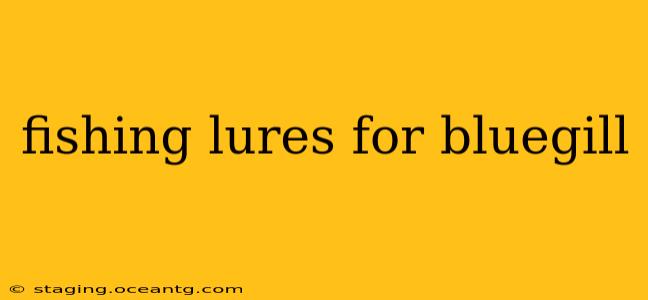Bluegill, with their vibrant colors and aggressive feeding habits, are a favorite target for anglers of all skill levels. However, choosing the right lure can significantly impact your success. This guide explores the best fishing lures for bluegill, covering various types, techniques, and considerations to help you land more of these panfish.
What are the best lures for catching bluegill?
The best lures for bluegill are those that mimic their natural food sources – small insects, crustaceans, and minnows. This often means opting for small, lightweight lures with subtle actions. While various lures can be effective, some stand out consistently:
-
Small Spinnerbaits: These lures, especially in sizes 1/16 to 1/8 ounce, with small, bright blades, create enticing flash and vibration that bluegill find irresistible. Choose colors like gold, silver, or chartreuse.
-
Small Crankbaits: Shallow-diving crankbaits in sizes ranging from 1 to 2 inches, mimicking small baitfish, are excellent choices. Natural colors like shad or crawfish patterns often work best.
-
Jigs: Small jig heads (1/32 to 1/16 ounce) paired with tiny plastic grubs, twister tails, or even small live bait like crickets or worms are extremely effective. Experiment with different colors to find what works best in your local waters.
-
Poppers: Surface lures like poppers can be highly effective, especially during periods of low light or when bluegill are feeding on the surface. Their erratic action mimics struggling insects.
-
Fly Fishing Lures: For those who enjoy fly fishing, small dry flies that imitate insects, or wet flies resembling nymphs or small baitfish, can be extremely successful.
What color lures work best for bluegill?
Bluegill are attracted to bright, flashy colors, but their preferences can vary depending on water clarity and time of day. Generally, these colors perform well:
- Chartreuse: A highly visible color that stands out in murky water.
- Red: A classic choice that often triggers aggressive strikes.
- Gold and Silver: These metallic colors mimic the flash of baitfish scales.
- Black and White: Effective in low-light conditions.
- Natural Colors: Crawfish, shad, and other baitfish patterns can be highly effective.
What size lures are best for bluegill?
Size matters when targeting bluegill. Lures that are too large can scare them off, while lures that are too small might not be noticeable. The ideal size range generally falls between 1/8 and 2 inches.
What type of fishing line should I use for bluegill?
Use a lightweight line, typically 4-6 pound test, to avoid spooking these sensitive fish. A high-visibility line can be beneficial in low-light conditions or stained water.
What are some tips for catching bluegill with lures?
-
Fish slowly: Bluegill are not known for their speed; slow and deliberate retrieves often trigger more bites.
-
Target structure: Bluegill often congregate around submerged vegetation, docks, and other structures.
-
Use light tackle: Light rods and reels are crucial for a sensitive presentation and more enjoyable fight.
-
Experiment: Try different lures, colors, and retrieves to discover what works best in your specific fishing location.
-
Pay attention to weather: Bluegill feeding patterns can vary based on weather conditions, such as temperature and sunlight.
By understanding bluegill behavior and employing the appropriate techniques and lures, you can significantly increase your chances of a successful fishing trip. Remember that patience and observation are key to mastering the art of bluegill fishing.
